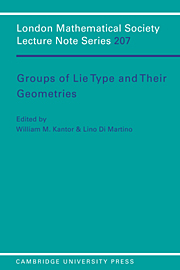Book contents
- Frontmatter
- Contents
- Preface
- List of talks
- List of participants
- Representations of groups on finite simplicial complexes
- Coxeter groups and matroids
- Finite groups and geometries: A view on the present state and on the future
- Groups acting simply transitively on the vertices of a building of type Ãn
- Finite simple subgroups of semisimple complex Lie groups – a survey
- Flag-transitive extensions of buildings of type G2 and C3*
- Disconnected linear groups and restrictions of representations
- Products of conjugacy classes in algebraic groups and generators of dense subgroups
- Monodromy groups of polynomials
- Subgroups of exceptional algebraic groups
- The geometry of traces in Ree octagons
- Small rank exceptional Hurwitz groups
- The direct sum problem for chamber systems
- Embeddings and hyperplanes of Lie incidence geometries
- Intermediate subgroups in Chevalley groups
- On a certain class of Frattini extensions of finite Chevalley groups
- Economical generating sets for finite simple groups
Embeddings and hyperplanes of Lie incidence geometries
Published online by Cambridge University Press: 06 January 2010
- Frontmatter
- Contents
- Preface
- List of talks
- List of participants
- Representations of groups on finite simplicial complexes
- Coxeter groups and matroids
- Finite groups and geometries: A view on the present state and on the future
- Groups acting simply transitively on the vertices of a building of type Ãn
- Finite simple subgroups of semisimple complex Lie groups – a survey
- Flag-transitive extensions of buildings of type G2 and C3*
- Disconnected linear groups and restrictions of representations
- Products of conjugacy classes in algebraic groups and generators of dense subgroups
- Monodromy groups of polynomials
- Subgroups of exceptional algebraic groups
- The geometry of traces in Ree octagons
- Small rank exceptional Hurwitz groups
- The direct sum problem for chamber systems
- Embeddings and hyperplanes of Lie incidence geometries
- Intermediate subgroups in Chevalley groups
- On a certain class of Frattini extensions of finite Chevalley groups
- Economical generating sets for finite simple groups
Summary
EMBEDDINGS OF POINT-LINE GEOMETRIES
Embeddings. Let be a point-line geometry, that is, an incidence system of points and lines, such that distinct lines possess distinct point-shadows, thus allowing lines to be viewed as sets of points. A projective embedding of point-line geometry Γ into the projective space P(V) of all proper subspaces of the vector space V is an injective mapping → projective points of P(V) = 1-spaces of V such that
(1) e(L) is a projective line for each line L of, and
(2) the image points span P(V).
Such an embedding is denoted by the symbol e : Γ → P(V).
Morphisms of embeddings. Let τ : V → W be a semilinear transformation of vector spaces. This induces a partial mapping of the corresponding projective spaces P(V) and P(W), sending points of P(V) not contained in kerr in P(V) to projective points of P(W). With some abuse of notation, we denote this by τ : P(V) → P(W). If e : Γ → P(V) is a projective embedding of the point-line geometry Γ, then composition with the partial map τ can yield a new embedding eτ if and only if
(1) τ is a surjective semilinear transformation, and
(2) For any points p and q of Γ, ker τ meets the subspace < e(p), e(q) > at the zero subspace of V.
- Type
- Chapter
- Information
- Groups of Lie Type and their Geometries , pp. 215 - 232Publisher: Cambridge University PressPrint publication year: 1995
- 5
- Cited by



